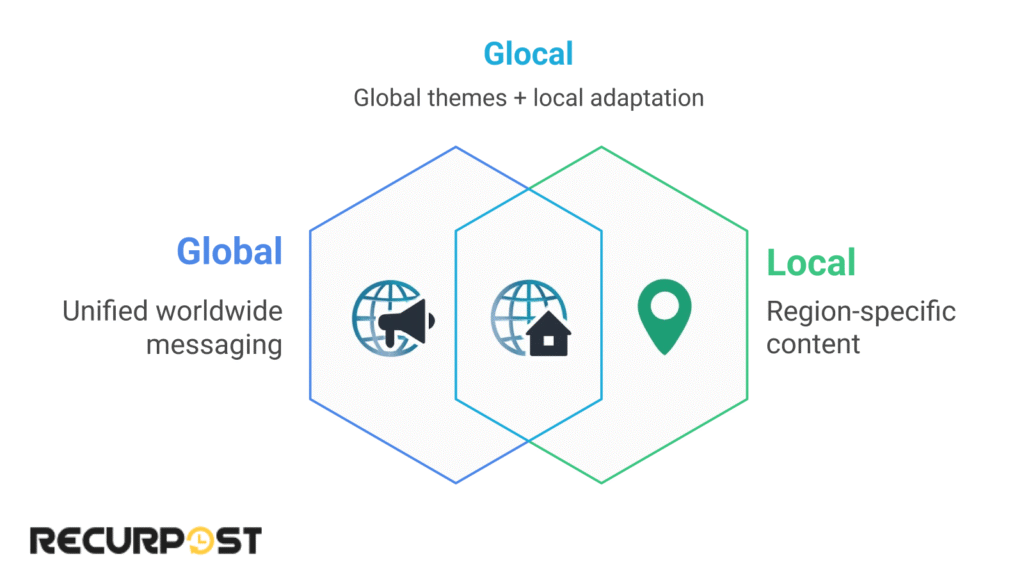Social media connects billions daily, giving brands access to a global audience far beyond their home markets. A Global Social Media Strategy helps brands keep their voice consistent while adapting to different cultures, languages, and preferences.
Strong media marketing strategies today go beyond platforms alone. Mobile-first content creation is vital, particularly in regions where social media users are expected to reach 5.42 billion by 2025. Success requires connecting social platforms with broader digital marketing efforts while handling time zones, cultural differences, and local audience behavior.
This guide shows how brands can balance global presence with local relevance. From choosing the right social media platforms to building a posting schedule that fits multiple regions, the steps outlined will support worldwide growth and stronger connections with diverse audiences.
What Is a Global Social Media Strategy?
A Global Social Media Strategy allows brands to connect with millions across countries while making each audience feel spoken to directly. It balances global reach with cultural respect, adapting brand messaging to local needs without losing consistency.
This social media marketing strategy scales with brand growth. It spans global platforms like Instagram, LinkedIn, and TikTok, as well as regional networks such as WeChat or VKontakte. Cultural sensitivity ensures the message stays relevant and respectful worldwide.
Global social media strategies can follow three methodologies depending on market reach and localization goals:
- Global: A single voice and unified message across all countries.
- Local: Content adapted for one region or country.
- Glocal: Global themes adjusted for local tastes and culture.

With nearly 94% of internet users active on social media, crafting a scalable plan has become essential for brands that want stronger international growth.
Why Global Brands Choose a Global Social Media Strategy

Global brands adopt a Global Social Media Strategy to connect across borders and grow their international presence. They benefit in several ways:
- Connects with regional audiences: Audience personas for each market guide tailored content. Short-form videos appeal to younger demographics, while posts and visual storytelling resonate with older groups.
- Targets the right platforms: The top social media platforms differ by country. Knowing which social channels your audience prefers: Instagram, WeChat, VKontakte, or others, ensures your message lands where it matters most.
- Builds brand advocates with local experts: Partnerships with micro-influencers and regional experts add authenticity. They produce user-generated content that drives engagement within trusted networks.
- Keeps messaging consistent yet flexible: A global account with localized content balances brand voice with cultural adaptation. This strengthens brand identity while respecting differences in language and traditions.
- Uses social listening for insights: Social listening tools uncover audience pain points and trending topics. Content teams can respond with timely posts that spark interaction and meaningful conversations.
- Powers lead generation and social commerce: Creative content, live video, and direct messages help attract new audiences, generate leads, and drive global sales.
A well-structured social media marketing strategy converts global audiences into loyal customers by customizing content delivery while staying aligned with core business goals.
Key Components of a Global Social Media Strategy
A Global Social Media Strategy works best when global brands focus on these areas to connect across regions and multiple social media channels:
1. Audience Research by Region
Detailed audience personas for each target market reveal habits, languages, and tone preferences. Social listening tools such as Brandwatch, Sprout Social, or Talkwalker deliver insights that shape content creation and improve engagement rate.
Example: Nike adapts campaigns for Gen Z versus Millennials based on global social media trends.
2. Cultural and Language Localization
Localization goes beyond translation. Content should resonate with values, customs, and cultural moments. Visuals and captions must align with regional tastes, making social media marketing locally relevant.
Example: KFC’s slogan issue in China highlights the need for cultural adaptation.
3. Platform Selection by Region
The top social media platforms vary worldwide: Instagram, LinkedIn, and X lead in the USA; WeChat and Weibo dominate China; VKontakte is popular in Russia; LINE and TikTok expand across Southeast Asia. Choosing the right social channels helps brands reach active users effectively.
Pro tip: Scheduling tools like RecurPost allow platform-specific publishing and keep the posting schedule consistent.
4. Time Zone Management
Global reach requires smart scheduling. Staggered content releases aligned with local time zones lift engagement rates. Brands use scheduling tools such as RecurPost to manage complexity.
Example: McDonald’s adjusts its posting schedule regionally to match peak audience activity.
5. Unified Brand Voice Across Markets
Consistency is vital for global content strategy. A central playbook defines fonts, colors, values, and hashtags. Local teams then add cultural context, keeping the brand voice authentic.
Example: Coca-Cola’s “Share a Coke” campaign shows how a unified theme adapts by name and language for a stronger local impact.
Craft a Successful Global Social Media Strategy
A Global Social Media Strategy begins with a global social media marketing plan, but success comes from consistent execution across regions and multiple social media platforms.
Step 1: Assemble the Right Team: A central group oversees the global account, while local experts manage individual social media accounts. This balance keeps the brand consistent while respecting regional needs.
Step 2: Use Social Listening Tools: Platforms such as Brandwatch or Sprout Social monitor conversations about your brand and competitors. These social listening tools deliver insights that guide timely content creation and lift engagement for global social media strategy.
Step 3: Manage content and scheduling with a unified calendar: A global content calendar aligns all social media channels. It maps posting schedules across time zones, cultural moments, and trending topics so content reaches audiences at peak activity.
Step 4: Use influencer marketing smartly: Partner with micro-influencers and brand advocates who know local nuances. Regional campaigns generate leads and boost engagement rates.
Step 5: Measure Performance Regionally and Globally: Track key metrics for each market and platform. Analytics show which social media channels and content deliver results, guiding adjustments to the marketing plan and helping meet business goals.
Step 6: Embrace Social Commerce and Direct Messaging: Add social commerce tools and direct messaging features to enable seamless shopping and customer support across multiple platforms.
Tools to Power Global Campaigns
Managing global social media accounts requires smart social media management tools that keep the marketing plan responsive across regions, campaigns, and multiple platforms. These tools strengthen any Global Social Media Strategy.
- RecurPost: Handles posting schedules across time zones, recycles evergreen content, and coordinates global teams. Custom queues assign content by language or region, while one dashboard streamlines publishing and content management across channels.
- Crowdin: Simplifies translation and localization so creative content resonates in different languages, strengthening content strategy for international campaigns.
- Native Analytics: Built-in tools such as Google Analytics, Facebook Insights, and Instagram Analytics show regional performance, target audience behavior, and engagement rates. These insights guide content marketing decisions that improve campaigns and reinforce a Global Social Media Strategy.
These tools keep social media campaigns coordinated, support smart decisions, and improve alignment between business goals and regional execution.
Case Studies: Brands That Nailed It
These case studies show how a Global Social Media Strategy delivers measurable results for global brands across regions and multiple social platforms.
1. Coca-Cola – “Share a Coke”
This campaign spanned more than 120 countries, printing local names on bottles while keeping a shared emotional theme. It inspired massive user-generated content and grew brand advocates worldwide, proving global brands can balance consistency with local flavor.
2. Always – #LikeAGirl
This campaign centered on a single empowering message that resonated across social media channels. Global influencer marketing fueled the movement, boosting engagement rates and brand favorability across multiple regions.
3. Spotify Wrapped
Spotify’s annual Wrapped campaign personalizes experiences for millions of users in dozens of countries. It blends global social media with regional customization, generating worldwide buzz while honoring local listening habits and cultural moments.
Global Social Media Challenges & Solutions
Running a Global Social Media Strategy brings hurdles, but brands solve them with planning, resource efficiency, and the right tools.
- Language barrier: Poor translation can harm brand image. Local editors add cultural sensitivity, ensuring copy reflects authentic values and feels relatable across markets.
- Time zone awareness: Automation tools such as RecurPost manage posting schedules for regional audiences across multiple time zones, keeping engagement consistent.
- Cultural missteps: Market research and collaboration with local experts prevent mistakes, aligning content with cultural moments and strengthening global relevance.
- Content overload: Scheduling tools recycle high-performing posts across multiple accounts. This supports resource efficiency and keeps feeds fresh without overwhelming global teams.
Tackling these challenges drives social media success and keeps the marketing plan on track across diverse platforms and social accounts.
To Sum Up
Global social media marketing goes further than managing accounts on major platforms. It builds authentic connections with global audiences through creative content, influencer marketing, and trusted brand advocates. With billions of social media users worldwide, each post or video can reach new regions and target markets.
Brands rely on social listening tools and performance data to match content with regional traits and cultural moments. Companies that listen, adapt, and interact across social channels generate leads, meet business goals, and build loyalty as social commerce grows.
What will your Global Social Media Strategy achieve next? Backed by social media statistics worldwide, the opportunity to connect across borders has never been greater.
FAQs on Global Social Media Strategy
1. How can social listening tools improve global social media marketing?
Social listening tools track conversations on social platforms to reveal pain points and social media trends. They help brands refine content creation and engage global audiences more effectively.
2. What role does influencer marketing play in a Global Social Media Strategy?
Influencer marketing builds trust by connecting with local experts and micro influencers. These creators produce authentic content, lift engagement, and make a social media marketing strategy more impactful worldwide.
3. How do I balance global consistency with local relevance?
Maintain a unified brand voice across accounts while letting regional teams tailor posts for cultural moments and unique audience personas.
4. What social media trends should international brands watch?
International brands should track short-form video, live video, and social commerce. These trends attract active users, expand reach, and help campaigns generate leads.
5. Why are audience personas important for global social media marketing?
They guide content creation by reflecting target market traits, ensuring campaigns resonate with different regional audiences.

Ruchi Dhimar is a skilled content writer with 5 years of experience. She is passionate about crafting compelling narratives, specializing in writing content for different industries.








